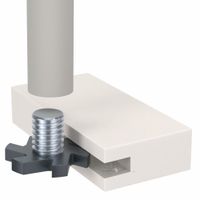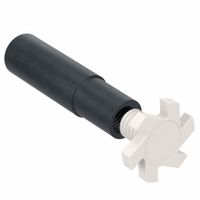Call +(254) 703 030 000 / 751 483 999 / 721 704 777
- Home
- Machining
- Indexable Cutting Tools
- Indexable Exchangeable Head Milling
- Exchangeable Head Milling Tools
.....Read More
Frequently Asked Questions
What are exchangeable-head milling tools?
Exchangeable-head milling tools are advanced cutting tools used in machining operations, designed to enhance efficiency and reduce costs. These tools consist of a tool body and a replaceable cutting head, allowing for quick and easy changes without the need to replace the entire tool. This modular design offers several advantages:
1. **Cost Efficiency**: By replacing only the worn or damaged cutting head instead of the entire tool, manufacturers can significantly reduce tooling costs. The tool body, which is more expensive, remains in use for a longer period.
2. **Versatility**: Exchangeable-head milling tools can accommodate various cutting heads, each designed for specific materials or applications. This flexibility allows for quick adaptation to different machining tasks, enhancing productivity.
3. **Reduced Downtime**: The quick-change capability minimizes machine downtime. Operators can swiftly swap out cutting heads, maintaining production flow and reducing the time spent on tool changes.
4. **Precision and Performance**: These tools are engineered to maintain high precision and performance. The secure connection between the tool body and the cutting head ensures stability and accuracy during milling operations.
5. **Inventory Management**: With exchangeable heads, manufacturers can maintain a smaller inventory of complete tools. Instead, they stock different cutting heads, optimizing storage space and reducing inventory costs.
6. **Sustainability**: By extending the life of the tool body and reducing waste from discarded tools, exchangeable-head milling tools contribute to more sustainable manufacturing practices.
Overall, exchangeable-head milling tools offer a practical solution for modern machining, combining cost savings, flexibility, and high performance to meet the demands of various industrial applications.
How do exchangeable-head milling tools work?
Exchangeable-head milling tools consist of a tool body and a replaceable cutting head, allowing for quick changes without removing the entire tool from the machine. The tool body is typically made of a durable material like steel, while the cutting head is often composed of carbide or other hard materials for effective cutting.
The cutting head is attached to the tool body via a secure locking mechanism, such as a threaded connection, a bayonet mount, or a clamping system. This design ensures precise alignment and stability during operation, maintaining the tool's performance and accuracy.
When the cutting head becomes worn or damaged, it can be easily replaced with a new one, minimizing downtime and reducing costs associated with tool replacement. This modularity allows for flexibility in machining operations, as different cutting heads can be used for various materials and applications without changing the entire tool.
Exchangeable-head milling tools are designed to maintain consistent cutting performance, with features like optimized chip evacuation, vibration dampening, and precise cutting geometries. These tools are suitable for high-speed and high-precision milling operations, offering versatility and efficiency in manufacturing processes.
What are the benefits of using exchangeable-head milling tools?
Exchangeable-head milling tools offer several benefits:
1. **Cost Efficiency**: These tools allow for the replacement of only the worn-out head rather than the entire tool, reducing costs associated with tool replacement and inventory.
2. **Versatility**: They provide flexibility in machining operations, as different heads can be swapped on the same shank to perform various tasks, such as roughing, finishing, or slotting, without changing the entire tool setup.
3. **Reduced Downtime**: Quick and easy head changes minimize machine downtime, enhancing productivity. Operators can swiftly switch heads without removing the tool holder from the machine, maintaining workflow continuity.
4. **Precision and Consistency**: Exchangeable heads are manufactured with high precision, ensuring consistent performance and accuracy across different machining operations. This precision contributes to maintaining tight tolerances and high-quality finishes.
5. **Inventory Management**: With fewer complete tools needed, inventory management becomes simpler. Companies can stock a variety of heads for different applications without the need for multiple complete tools, optimizing storage space and reducing inventory costs.
6. **Environmental Impact**: By replacing only the head, less material is discarded compared to replacing entire tools, contributing to more sustainable manufacturing practices.
7. **Customization**: Manufacturers can tailor the tool head to specific materials or applications, optimizing performance for particular tasks and materials, such as aluminum, steel, or composites.
8. **Tool Life**: The ability to replace only the cutting head can extend the overall life of the tool system, as the shank and other components are subject to less wear and tear.
These benefits make exchangeable-head milling tools a practical choice for modern manufacturing environments, where efficiency, flexibility, and cost-effectiveness are paramount.
What types of cutting heads are available for exchangeable-head milling tools?
Exchangeable-head milling tools offer versatility and efficiency in machining operations. The types of cutting heads available for these tools include:
1. **Square Shoulder Heads**: Designed for creating precise 90-degree shoulders and slots, these heads are ideal for general-purpose milling.
2. **Face Milling Heads**: Used for high-efficiency face milling operations, these heads provide a smooth surface finish and are suitable for large surface areas.
3. **Ball Nose Heads**: Perfect for 3D contouring and complex surface machining, ball nose heads are commonly used in die and mold applications.
4. **Chamfering Heads**: These heads are used to create beveled edges or chamfers on workpieces, enhancing the aesthetic and functional aspects of the part.
5. **Copy Milling Heads**: Designed for profiling and contouring, these heads are used in applications requiring intricate shapes and patterns.
6. **High-Feed Heads**: These heads allow for high-speed material removal with shallow depth cuts, increasing productivity in roughing operations.
7. **Thread Milling Heads**: Used for creating internal and external threads, these heads offer precision and flexibility in threading operations.
8. **T-Slot Milling Heads**: Specifically designed for machining T-slots, these heads are used in applications like machine table manufacturing.
9. **Slotting Heads**: Ideal for cutting slots and grooves, these heads are used in various applications requiring precise slot dimensions.
10. **Roughing Heads**: Equipped with serrated cutting edges, these heads are used for heavy material removal in roughing operations.
11. **Finishing Heads**: Designed for achieving high-quality surface finishes, these heads are used in the final stages of machining.
12. **Indexable Insert Heads**: These heads use replaceable inserts, offering cost efficiency and reduced downtime for tool changes.
Each type of cutting head is designed to meet specific machining requirements, enhancing the flexibility and efficiency of exchangeable-head milling tools.
How do you change the cutting head on an exchangeable-head milling tool?
1. **Safety First**: Ensure the machine is turned off and disconnected from the power source. Wear appropriate personal protective equipment, such as gloves and safety glasses.
2. **Secure the Tool**: Place the milling tool in a stable position, either in a vice or on a workbench, to prevent movement during the head change.
3. **Remove the Current Head**:
- Locate the locking mechanism, which could be a screw, bolt, or clamp, depending on the tool design.
- Use the appropriate tool (e.g., wrench, Allen key) to loosen and remove the locking mechanism.
- Carefully detach the current cutting head from the tool body, ensuring not to damage the tool or the head.
4. **Inspect the Tool and New Head**:
- Check the tool body and the new cutting head for any signs of wear or damage.
- Clean the contact surfaces to ensure a secure fit and optimal performance.
5. **Attach the New Head**:
- Align the new cutting head with the tool body, ensuring the orientation is correct.
- Secure the head by tightening the locking mechanism. Ensure it is firmly attached but avoid over-tightening, which could damage the tool or head.
6. **Test the Setup**:
- Reconnect the machine to the power source.
- Perform a test run at a low speed to ensure the new head is properly installed and balanced.
- Listen for any unusual noises or vibrations, which could indicate improper installation.
7. **Final Adjustments**: Make any necessary adjustments to the tool settings based on the new head specifications and the material to be milled.
What materials can be machined with exchangeable-head milling tools?
Exchangeable-head milling tools are versatile and can machine a wide range of materials. These include:
1. **Steel**: Both low and high carbon steels, as well as alloy steels, can be effectively machined. The tools are designed to handle the toughness and hardness of steel, providing precision and efficiency.
2. **Stainless Steel**: These tools can machine various grades of stainless steel, which are known for their corrosion resistance and strength. The tools are capable of maintaining sharpness and precision despite the material's work-hardening properties.
3. **Cast Iron**: Gray, ductile, and malleable cast irons can be machined with these tools. The tools are designed to handle the abrasive nature of cast iron, ensuring smooth operations and extended tool life.
4. **Aluminum**: Exchangeable-head milling tools are ideal for aluminum and its alloys, offering high-speed machining capabilities and excellent surface finishes due to aluminum's softer nature.
5. **Titanium**: These tools can machine titanium, which is known for its strength-to-weight ratio and corrosion resistance. The tools are engineered to manage the heat and wear associated with titanium machining.
6. **Nickel Alloys**: Superalloys like Inconel can be machined with these tools. They are designed to withstand the high temperatures and stresses involved in machining these tough materials.
7. **Copper and Brass**: These softer metals can be machined efficiently, with the tools providing excellent surface finishes and precision.
8. **Plastics and Composites**: Various plastics and composite materials can be machined, with the tools offering the necessary precision and surface quality.
9. **Hard Materials**: Some exchangeable-head milling tools are designed to machine hard materials like hardened steel and ceramics, using specialized coatings and geometries to maintain performance.
These tools are adaptable, offering flexibility and efficiency across diverse machining applications.
How do exchangeable-head milling tools compare to solid tools in terms of performance and cost?
Exchangeable-head milling tools and solid tools each have distinct advantages and disadvantages in terms of performance and cost.
Performance:
1. **Exchangeable-Head Tools**: These tools offer flexibility as the cutting head can be replaced without changing the entire tool body, allowing for quick adaptation to different materials and applications. They provide consistent performance with high precision and are ideal for complex machining tasks. However, they may not be as robust as solid tools in heavy-duty applications due to potential head-body connection issues.
2. **Solid Tools**: Known for their rigidity and strength, solid tools excel in heavy-duty and high-speed machining operations. They offer superior stability and vibration resistance, leading to better surface finishes and longer tool life in demanding conditions. However, they lack the versatility of exchangeable-head tools, as the entire tool must be replaced when worn out or when a different size or geometry is needed.
Cost:
1. **Exchangeable-Head Tools**: Initially, these tools may have a higher upfront cost due to the need for a compatible tool body. However, they can be more cost-effective in the long run as only the head needs replacement, reducing material waste and inventory costs. They also minimize downtime, as head changes are quicker than replacing entire tools.
2. **Solid Tools**: These tools generally have a lower initial cost compared to exchangeable-head systems. However, the need to replace the entire tool when worn or when different specifications are required can lead to higher long-term costs. Additionally, inventory management can be more complex and costly due to the need for multiple tool sizes and types.
In summary, exchangeable-head tools offer flexibility and potential cost savings over time, while solid tools provide superior performance in heavy-duty applications but may incur higher long-term costs.




